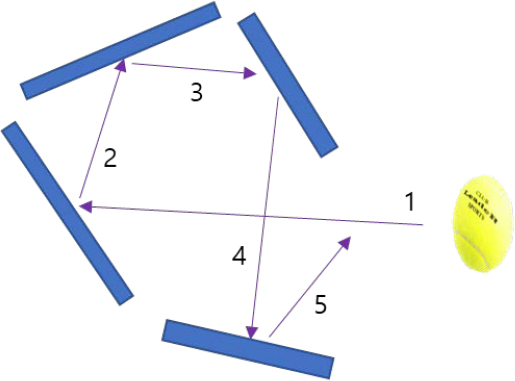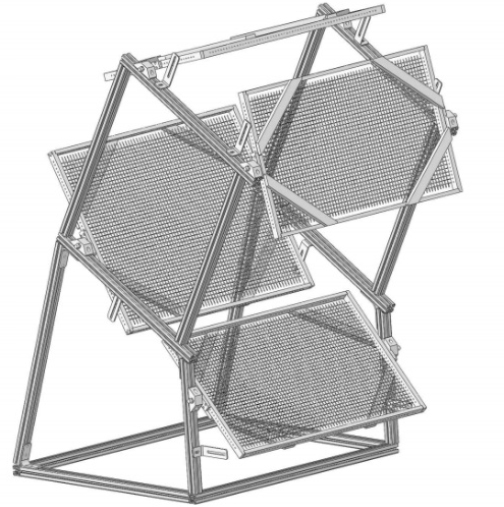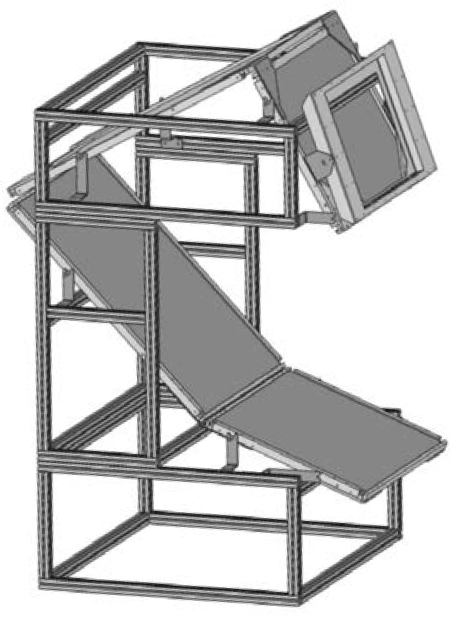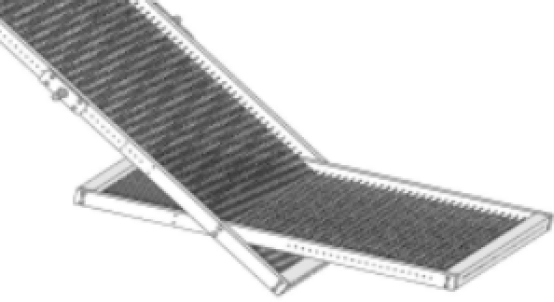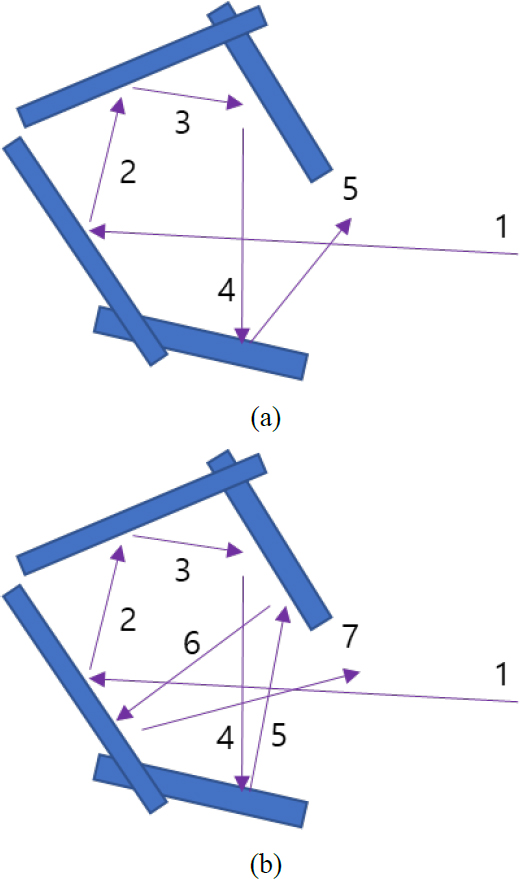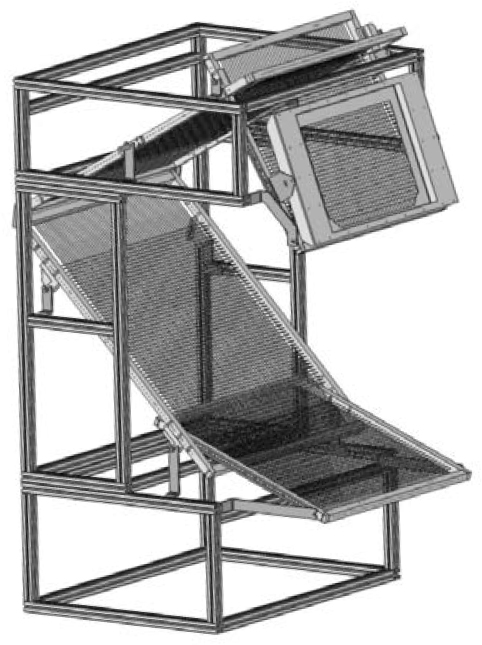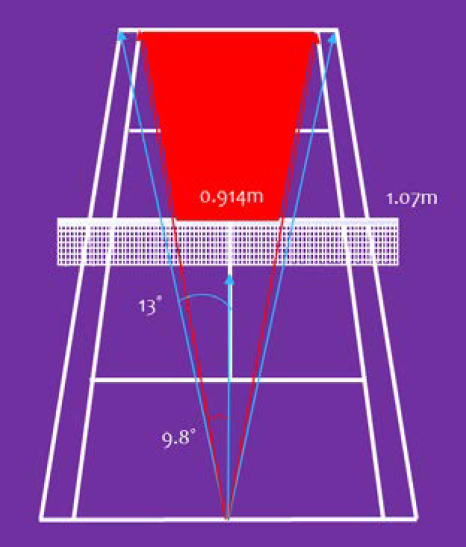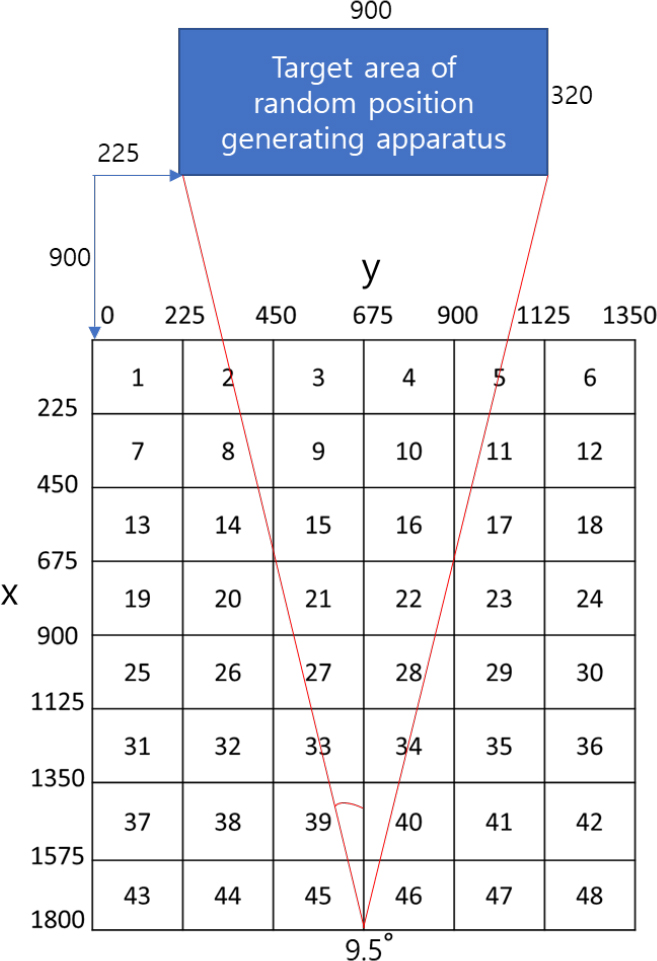
Multi-directional random ball generator based on impact characteristics without inter-frame interface
Copyright © The Korean Society of Marine Engineering
This is an Open Access article distributed under the terms of the Creative Commons Attribution Non-Commercial License (http://creativecommons.org/licenses/by-nc/3.0), which permits unrestricted non-commercial use, distribution, and reproduction in any medium, provided the original work is properly cited.
Abstract
Tennis is a popular sport because of its excellent physical benefits; however, many individuals abandon the sport owing to the lengthy training period required to acquire game-ready skills. This is often due to the challenges of adapting to real game conditions on tennis courts after lessons. On the court, balls exhibit random positions and unpredictable timing; traditionally, players can only improve their adaptability through actual matches.
This paper presents a multi-directional random ball generator that features randomness in ball placement and timing based on impact characteristics. The device uses a single ball that returns to the user with random bounce location and timing when struck. With this device, users can practice independently without requiring a skilled partner and can develop the ability to respond effectively to varying ball positions and timings on their own. By replicating the characteristics of a tennis court, consistent practice with this device helps players adapt more efficiently to real game conditions.
Keywords:
Multi-dimensional, Random position, Random timing, Without interface area, Ball1. Introduction
In tennis, the goal is to hit the ball over the net such that it bounces within the opponent’s court. If the ball is hit too softly, it may not clear the net or result in an easy return to the opponent. Conversely, hitting the ball too hard may make it difficult for the opponent to return, but it increases the risk of the ball going out of bounds. Therefore, controlling the force and angle of the racket is essential for creating a strong yet accurate shot that remains within the end line.
Research on the physical benefits of tennis has analyzed the energy consumption patterns of beginners and advanced players [1]. Energy expenditure was measured for forehand, backhand, and front-hand strokes using accelerometers placed on the wrist, waist, and ankle. This study determined that advanced players consumed more energy in the ankle area, whereas beginners consumed less energy in the waist area, indicating a lack of proper posture in the latter. No significant differences were observed in wrist energy consumption between the two groups.
A smart tennis ball system was utilized to measure the revolutions per minute (RPM) of the tennis ball [2]. This system successfully demonstrated accurate RPM measurements, real-time visualization of ball spin, and the potential for innovative applications in tennis training. In tennis, the ball’s spin after being hit is crucial, as it applies the Magnus effect, which generates a force pushing the ball toward the lower pressure side by creating a pressure difference between slower and faster airflows around the ball. A common application of the Magnus effect in tennis is the use of the topspin to maintain a powerful shot inbound. The initial spin imparted by the opponent’s stroke significantly affects the resultant spin, which in turn determines the Magnus force. This study demonstrates a sensor-based system that provides tennis players with quantitative feedback in the form of the RPM generated by their strokes and the spin plane of the ball. Using this technology, players can incrementally improve their return strokes, while receiving measurable feedback on their performance.
A 3D skeletal estimation model was presented in a video analysis, showing the possibility of comparing a user’s swing with that of a professional to facilitate improvement [3]. Computer vision was used to detect the ball’s position in real-time within the frame and infer the game state based on a sequence of detections. This enabled the extraction of a statistical set to quantify tennis player performance. By optimizing state-of-the-art object detection algorithms, methods have been developed to analyze tennis match footage and to extract various game-related statistics that players can use to enhance their performance. In addition, the stored data support the creation of a system that can simulate a player’s game in real time.
By detecting the ball’s position in real-time and inferring the game state from the detection sequence, the system quantifies player performance using statistical sets [4]. Computer vision, a field that focuses on interpreting images or image sequences, employs techniques to detect objects within frames and track changes in their positions across multiple frames. By optimizing advanced object detection algorithms, tennis match videos were analyzed and statistical insights into player performance were generated. Players can leverage these statistics to improve their skills. Furthermore, a system that uses stored data to simulate a player’s game in real-time was proposed.
While analyzing energy consumption, ball spin rate, user swings, and game states can help develop partial tennis skills, improving practical hitting performance requires extensive practice to enhance hitting power and accuracy. Beginners must start by practicing using consistently delivered balls; however, to adapt to real court scenarios, they must train with randomly delivered balls influenced by the opponent’s hits. Although consistent ball practice is convenient, it does not prepare players for game-like situations.
In sports such as tennis, where players must respond to randomly directed balls, practicing with consistent balls has certain limitations. Most existing training systems rely on repetitive patterns, and ball machines, although equipped with random features, do not account for the striking characteristics of the users. Devices that are capable of generating truly random balls based on player hits are rare. Currently, the only way to practice hitting random balls during tennis games is by trial and error. Even extensive practice with consistent balls does not adequately prepare players to adapt to random balls, requiring significant additional game experience to develop mastery. This often results in a prolonged time required to reach proficiency.
To address this issue, this study introduces a multi-directional random ball generator based on the striking characteristics. The proposed system produces balls with bounce positions and time intervals that change randomly for each return. Moreover, random features are linked to the characteristics of the players’ hits. This behavior replicates how balls hit by a player on a tennis court exhibit random traits that reflect the initial hit before reaching the opponent.
The multi-directional random ball generator apparatus developed in this study functions as a simulator to replicate the characteristics of tennis courts. This enables players to practice extensively using randomly delivered balls. Consequently, it significantly improves the ability of tennis courts to adapt to real gaming conditions. The proposed system accelerates the improvement in real-game adaptability, allowing players to adjust to court play in a shorter time.
This study presents a multi-directional random ball generator apparatus based on its hitting characteristics. When a ball hits toward the device and reaches the target area, it bounces off at a reflective angle, striking subsequent surfaces in a chain reaction before returning to the user in a random direction. If there are dead zones at the boundaries where the surfaces meet, the ball may bounce unpredictably, disrupting smooth returns. Therefore, minimizing these dead zones is essential for continuous strike and return.
2. Experimental Methods
The multi-directional random ball generator consists of four elastic surfaces, as illustrated in Figure 1. Each surface was strung using a tensioned cord. When the ball strikes a surface, it rebounds at an angle determined by elastic tension. The ball then travels in the direction opposite to the other surface. This repetitive interaction allows the trajectory and bounce count of the ball to be influenced by the striking direction and velocity. After sequentially striking three or four surfaces, the ball was returned to the user with a randomized trajectory and speed, mimicking the randomness of real tennis gameplay.
The initial model of the multi-directional random ball generator is shown in Figure 2. However, boundaries (dead zones) exist between the surfaces, causing irregular bounces when the ball comes in contact with these zones. To address this issue, minimizing the boundary size is critical.
The simplest way to minimize the boundary zones is to use a plate-based structure, as shown in Figure 3. The use of flat plates to connect the four surfaces reduces boundary irregularities. However, the elasticity of the flat plates was insufficient, leading to inadequate rebound and preventing the ball from traveling to adjacent surfaces.
To minimize the boundary zones while using string-mesh surfaces, the boundaries where the two surfaces meet are designed to cross each other, as shown in Figure 4. The length of the frame along the edges where the strings were secured was extended beyond the original surface dimensions, allowing the strings to overlap at the edges of the two adjoining surfaces. This design minimizes the size of the boundary zone compared with that shown in Figure 2, thereby reducing irregular bounces. In addition, the boundary angle can be adjusted as required to provide flexibility to the setup.
The four surfaces of the multi-directional random ball generator are structured as shown in Figure 5. The surface on which the struck ball lands is equipped with appropriate elastic strings, allowing the ball to return to the user with minimal speed loss, even after bouncing several times. The proposed device enables the practice of powerful strikes against balls with random characteristics but is more specialized for practicing precise hits to send the ball to target areas. When a ball strikes one of the surfaces, it bounces back to the user based on the angles of incidence and reflection. The final model of the multi-directional random ball generator, as shown in Figure 6, consists of four surfaces with evenly tensioned strings across them. To minimize the dead zones between surfaces, two adjacent surfaces were designed to cross each other with strings strung across them. In addition, the inclination angle can be adjusted if required. The dimensions of the device were 1450 mm × 1100 mm × 2000 mm. On the second surface (from the bottom), the opponent’s court is visible, serving as the target area for practice. The training involved aiming shots at the target area, which had a lower boundary set at 90 cm. The target area was designed to simulate the opponent’s court zone on a tennis court.
On a tennis court, the left and right angles from the center of the baseline to the single lines were approximately 9.8 °, as shown in Figure 7. Similarly, the multi-directional random ball generator produces a target area with an angle of approximately 9.5 °relative to the user, as shown in Figure 8. On an actual court, hitting outside of the 9.8-degree angle results in the ball being out of bound. The angle of the ball generator closely mirrors this characteristic, effectively scaling down the proportion of tennis courts. Although the device may appear narrower at first glance, it faithfully replicates the court’s geometry on a smaller scale.
Figure 8 illustrates the bounce position area. The blue area represents the target zone for the ball. The front of the device was divided into 48 sections, each measuring 225 mm × 225 mm. The location and the time of ball return were measured. The randomness of the ball trajectory was verified for each strike by observing the bounce positions. When lessons are conducted using a multi-directional random ball generator, users can observe the coach’s demonstrations in close range and receive detailed explanations effectively. As illustrated in Figure 8, when hitting towards the target area of the multi-directional random ball generator is hit from the center, the permissible angles to the left and right are 9.5 °. This is similar to the 9.8° permissible angle on a tennis court, indicating that the multi-directional random ball generator mimics these characteristics.
3. Results and Discussion
The positions of the balls in the experimental device that landed on the ground were measured. The x and y directions used in Figure 9 are shown in Figure 8. As shown in Figure 9, the landing position varied each time. The hit ball bounces within the multi-directional random ball generator and travels to different surfaces; after undergoing several bounces, it lands on the ground before being returned to the user. The bouncing characteristics within the generator depend on the hitting direction, position, speed, and height of the user, which also affect the position at which the ball lands and is returned.
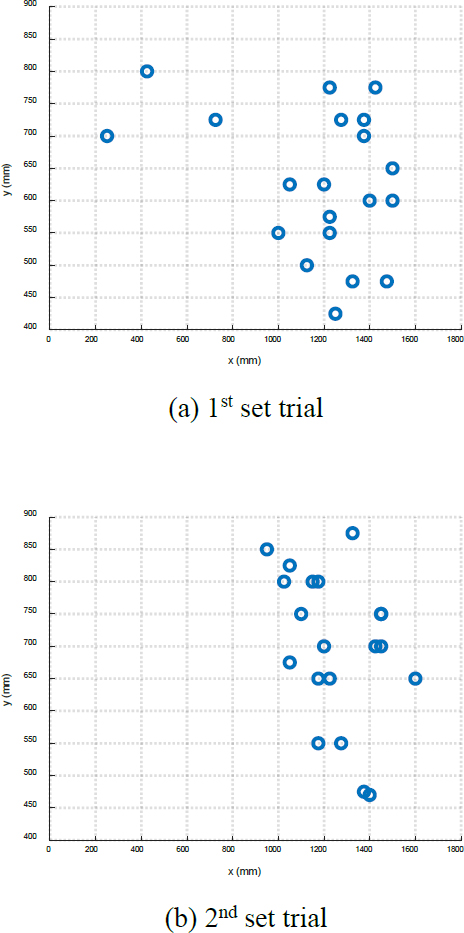
Bounce characteristics during the operation of the multi-directional random ball generator during 20 continuous hitting
The time interval of the returned ball also varies randomly depending on the characteristics of the ball, number of bounces within the generator, and its speed, as shown in Figure 10. Figure 10(a) shows the bound positions and the time required for each of the 20 consecutive hits. Figure 10(b) illustrates the characteristics of a new set of 20 hits separated from the conditions in Figure 10(a). It can be observed that each bound position and time in Figure 10(a) exhibit random characteristics, and Figure 10(b) also demonstrates random characteristics in the bound position and time, independent of Figure 10(a). The user must move quickly to the position of the bounced ball and hit it on time. By observing the direction and bouncing of the returning ball, the user can adjust its position and timing to hit the ball. Because the bounce positions change randomly each time, the user develops agility and responsiveness while remaining engaged and alert during practice. The proposed device features random characteristics influenced by the user’s force and stroke direction when hitting the ball. These features enable the proposed device to reflect the conditions of tennis courts. Using the proposed device, users can develop superior adaptability, enabling them to perform better during tennis court rallies.
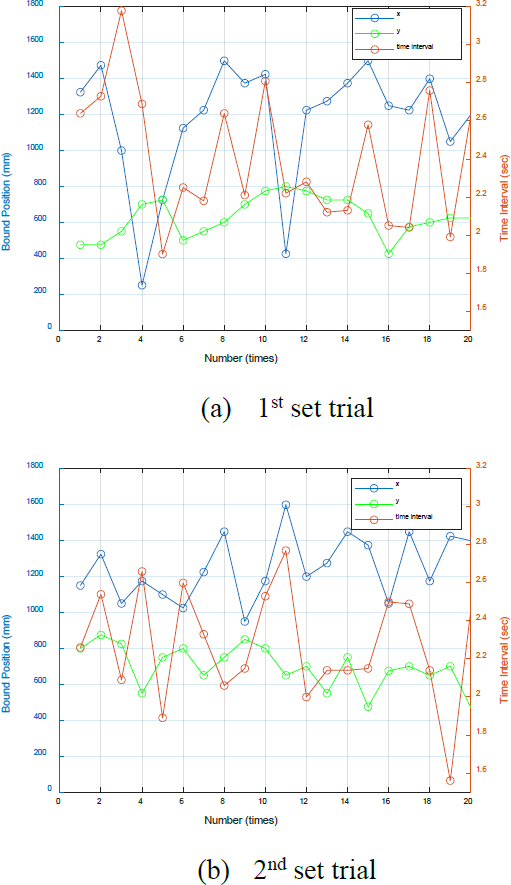
Bounce characteristics during the operation of the multi-directional random ball generator during 20 continuous hitting
The randomness of the bounces requires an instantaneous reaction, allowing for enjoyable and focused training sessions. Using only one ball enables continuous practice, making training highly time efficient. Many striking practices can be implemented within a short period. Compared to tennis courts, which offer broader random bounce areas, this smaller area with random bounces allows beginners to adapt step-by-step.
4. Conclusion
A multi-directional random ball generator was used in this study. This device represents randomness in the bounce positions based on the striking characteristics of the user, as well as in the time intervals between hits, which vary randomly between 2 and 3 s. When hitting towards the target area, the permissible left-right angle was 9.5 °, and the lower limit of the target area was 90 cm. These characteristics are similar to those experienced by the users during tennis court rallies.
In tennis, players typically learn basic shots such as strokes, volleys, and smashes, and serve through lessons before transitioning to rallies and games in court. During lessons, the trajectory and position of balls are often predictable, allowing players to focus on developing their form of hitting. However, during rallies or games on court, the bounce positions of the balls vary randomly depending on the previous hit. The time intervals between hits also change based on factors such as speed, spin, and trajectory of the ball. For beginners, this randomness in bounce position and timing makes it challenging to adjust their hitting position and timing, resulting in a longer adaptation period in tennis courts.
The multi-directional random ball generator mimics the characteristics of a tennis court, but on a smaller scale. Adapting to the randomness of a tennis court is only possible through actual gameplay, which poses significant difficulties and requires considerable time for beginners. This device allows players to practice hitting in a smaller area while maintaining randomness in the bounce positions and time intervals, making it easier for beginners to handle the unpredictability of the ball.
Through practice with the apparatus, users naturally develop skills to respond to the randomness encountered during actual tennis games. By experiencing tennis court-like characteristics in advance, players can adapt more effectively to court rallies and games. Using the multi-directional random ball generator helps beginners transition to tennis court gameplay more quickly, reducing the adaptation time significantly. It is expected that this device will be utilized in the future development of AI-based actuator technology that senses the trajectory of randomly incoming balls and strikes them to go towards the target area.
Author Contributions
Conceptualization, P. W. Heo.; Methodology, P. W. Heo.; Software, P. W. Heo.; Formal Analysis, P. W. Heo.; Investigation, P. W. Heo.; Resources, P. W. Heo.; Data Curation P. W. Heo.; Writing-Original Draft Preparation, P. W. Heo.; Writing-Review & Editing, P. W. Heo.; Visualization, P. W. Heo.; Supervision, P. W. Heo.; Project Administration, P. W. Heo.; Funding Acquisition, P. W. Heo.
References
-
T. He and Q. Luo, “Energy consumption assessment of college tennis players based on Actigraph GT9X accelerometer,” Advances in Intelligent Systems and Computing, 1018, pp. 549-555, 2020.
[https://doi.org/10.1007/978-3-030-25629-6_85]

-
Y. K. Foo, X. Li, and R. Ghannam, “Enhancing tennis practice: sensor fusion and pose estimation with a smart tennis ball,” Sensors, vol. 24, no. 16, 5306, pp. 1-27, 2024.
[https://doi.org/10.3390/s24165306]

-
Y. Hiramoto, M. Al-Sada, and T. Nakajima, “Design and implementation of a virtual reality tennis serve practice system for creative tennis serve practice,” Lecture Notes in Computer Sciences, 14708 LNCS, pp. 84-102, 2024.
[https://doi.org/10.1007/978-3-031-61047-9_5]

-
P. Shiralagi, R. Bhandary, and B. Rajeshwari, “A novel approach to tennis game analysis and emulation using computer vision,” Proceedings of the 2020 IEEE International Conference on Communication and Signal Processing, ICCSP 2020, pp. 286-292, 2020.
[https://doi.org/10.1109/ICCSP48568.2020.9182453]


